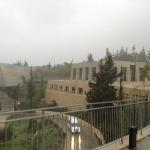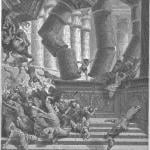 Jonathan Pennington is Assistant Professor of New Testament Interpretation at the Southern Baptist Theological Seminary. He published his thesis with Brill’s Novum Testamentum Supplement Series – a very wise choice. He was kind enough to share his experience with me.
Jonathan Pennington is Assistant Professor of New Testament Interpretation at the Southern Baptist Theological Seminary. He published his thesis with Brill’s Novum Testamentum Supplement Series – a very wise choice. He was kind enough to share his experience with me.
What is especially exciting is that he has published his thesis additionally as an affordable paperback book with Baker Academic. Now it will be widely available at a reasonable price.
Q1: As I recall, you studied at St. Andrews with Prof. Bauckham. Did you ask him or did he give you any particular advice about how to publish your thesis?
[Jonathan Pennington] It has been several years now so I don’t recall exactly, but I certainly must have asked his advice on publication at some point. He was always very kind and helpful. I do remember him saying once that during his tenure as the editor of the SNTS Monograph Series he felt it was not entirely appropriate to recommend his own students’ works for that series, but that now that he had stopped serving as the editor he once again was glad to point his students in that direction. This is a testimony to his own integrity and scholarship.Beyond this, however, I believe I got more direct advice and suggestion from my readers, that is, the scholars who examined me for my viva, or defense. [For those not familiar with the British PhD system, the candidate must finally defend his or her thesis (or dissertation, in American terms) before two scholars who were not involved in the supervision of the writing. One of these must be internal (from one’s own university) and one external (from elsewhere).] My readers were Bruce Longenecker and Mark Goodacre, both of whom gave excellent and very encouraging points. Before I had even left the viva room they had both made clear to me that this was a publishable book requiring little revision. This obviously encouraged me to pursue publication and at the highest levels.
Q2: What drew your attention to Novum Testamentum Supplements? What are the benefits of publishing with them?
[Jonathan Pennington] As I said, I was reasonably confident in light of how well my defense went that I would be able to get the work published. There seemed to be a general understanding among post-grads and professors which series were the most well-recognized and well-respected and so obviously these were the most desirable to pursue. At the top of this list for NT studies seemed to be Brill’s NovTestSupp and Cambridge’s SNTSMS. These not only have a long history of being places where seminal works have been published, but they also have the renown of being connected to two of the most venerated NT academic institutions, the journal Novum Testamentum and the Society for New Testament Studies. This is not to put down other important institutions, journals, and series such as JSNT or WUNT. But simply, for whatever reasons, NovTestSupp and SNTSMS seemed to me to be shooting for the very top.
I made initial contact with Cambridge, but two things stalled this process. One was a more restrictive page limit for SNTSMS — mine would have been over at 370+ pages and of course there was simply nothing I could cut out! :). The other was the pragmatic reality that another scholar, Dan Gurtner, had just submitted his thesis, also on Matthew, and also supervised by Bauckham, for consideration in the series. As the editor, John Court, apologetically explained, this slowed things down quite a bit especially because it was difficult to find another Matthew scholar on short notice who could read the book and comment for publication. I think there was sincere interest, but I decided I did not want to wait and was glad to turn to Brill. My reading of several volumes in this series convinced me that it would be a great honor to be published by them. (Subsequently, Dan’s excellent book was picked up and published by Cambridge.)
Q3: How much re-working or modifying did you do on your thesis before you sent it off to NovTSup?
[Jonathan Pennington] I sent an initial inquiry to Margaret Mitchell who serves as the editor forthis series. She expressed interest and so I sent along a full proposal and at some point the whole manuscript. Between the proposal and submitting the manuscript I made a few adjustments suggested at my viva, but none of these were very significant. The biggest thing I did was to rewrite Chapter One. As I continued to consider the arguments I felt it would be more persuasive to restructure how I prosecuted the thesis of that chapter. There was no new content, but a better presentation. Other than that, nothing much else was changed beyond the ever-creeping-in typos.
Q4: How much work did you have to do once the manuscript was accepted? How long did it take?
[Jonathan Pennington] Some months later I received the positive word from Professor Mitchell. She informed me that the readers liked the work and had made only minor suggestions for improvement and that the editors would be happy to accept the book in their series. You can imagine there was much rejoicing in the Pennington household that day! At this point I worked on the suggestions made — usually things like pursuing initial sources rather than quoting people quoting people — and resubmitted the manuscript. Later on, after Brill had proofed it, I and a PhD student of mine re-read the whole thing in galley form. This whole process took something like 6 months if I recall correctly.
Q5: Looking back on your publishing experience, what might you have done differently, if anything?
Brill was brilliant! They were professional, kind, and took over the whole process with ease. I cannot imagine a better experience than what I had, especially being such a novice.
Q6: You have, now, a new edition of your thesis work published with Baker. How does that work? Does that mean the NovTSup edition is out of stock? Did Baker approach you?
[Jonathan Pennington] I have long respected Baker and the way forward they are going under the editorial leadership of Jim Kinney. Over the years I had many good interactions with Jim and so one year at SBL, shortly after the Brill volume came out, I pitched to him the idea that I thought this book could use a broader readership than it would get in a purely academic series, especially one that was so expensive ($185; I couldn’t even afford to buy one for my mom). I knew it would be a hard sell to publish a PhD thesis, but I hoped that it was somewhat different than most dissertations in that it did not cover just one passage or particular point, but offered a macro-level theme for understanding Matthew and the huge idea of the kingdom of heaven. Whether I was just foolishly naive or correct, the reader will have to decide! My proposal to him included comments and recommendations I had received, including the very kind words of Dale Allison (one of my top 5 favorite NT scholars) who had been my NovTestSupp reader.
It took Jim a few months to get back to me, but then one day he called to say that he had finally gotten around to reading the portions I had sent him and he liked it very much and thought it was readable and significant. We went through the formal proposal process with Baker and it was accepted. (More rejoicing in the Pennington household.)
So, the Baker version is not really a new edition, but simply a paperback reprint of the Brill volume, as is — with the one change — it now costs about $150 less!
I believe technically it is still in print with Brill, but again, the price is prohibitive for the individual reader to buy it. Brill required that Baker wait 18 months before publishing the pb version so that they could get whatever sales they could. Beyond that, the legal details are beyond me! I just sign the contracts.
Q7: Out of curiosity, do you mind sharing what other projects you have on your table for the future?
[Jonathan Pennington] Certainly. I am currently working on a number of essays, including one on the Lord’s Supper in the Synoptics and on a theology of work in Matthew. The biggest projects on my horizon are that I have agreed to write the Pillar NT Commentary on Matthew to replace the Leon Morris volume. This is a 5-6 year out project. As has been said about writing, I like the idea of having written this volume more than the actual mountain that it will be to do so! But closer on the horizon I am using my upcoming sabbatical to, Lord willing, write a book on how to read the Gospels theologically. I consider myself part of the ‘theological interpretation of Scripture’ movement and am very keen on hermeneutical and history of interpretation issues. I want to apply these new hermeneutical turns specifically to reading the Gospels as Holy Scripture.











